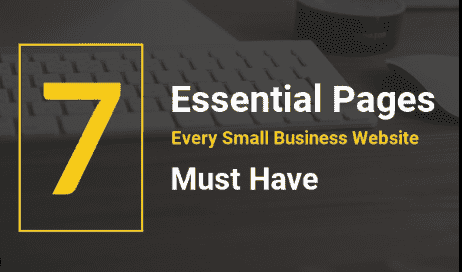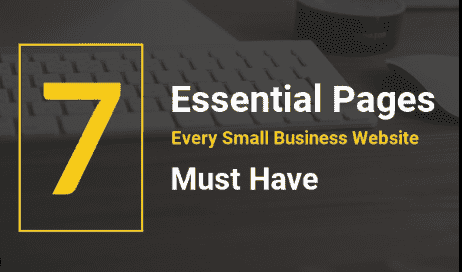essential pages for a website: introduction
Creating an online website entails careful planning and company to ensure it is person-best, functional, and meets your organization’s emblem’s organization’s dreams. Here are essential pages that each internet site should have, along with aspect-positive descriptions of what everyone has to include:
Home Page
Purpose:
The home page is The main thing people notice about your website. It should showcase your brand and what you offer and invite customers to learn more.
Key Elements:
Headline and Sub-headline:
Make it clear what you do or what the website is set.
Hero Image or Video:
Visually enticing media to attract interest.
Navigation:
Easy-to-discover menu with hyperlinks to critical pages.
Call-to-Action (CTA):
Encourage traffic to take the next step (e.g., “Learn More,” “Contact Us,” “Shop Now”).
Brief Overview:
Highlight critical elements of your Business, services, or content.
Social Proof:
Testimonials, reviews, or emblems of partners and customers.
About Us Page
Purpose:
Provide site users with information about your Business, its history, its goals, and its group.
Key Elements:
Company History:
A brief narrative of the founding and growth of your Business for profit.
Mission and Values:
What drives your business venture, and what do you stand for?
Team Members:
Photos and bios of crucial crew participants to add an intimate touch.
Awards and Achievements:
Any outstanding honours.
Company Culture:
Insights into what it is like to paint with or to your Business.
Services or Products Page
Purpose:
Detail the services or products you volunteer for, helping traffic understand how you could meet their desires.
Key Elements:
Service/Product Listings:
Detailed descriptions, features, and benefits.
Pricing Information:
Clearly stated expenses or a way to get a quote.
Images or Videos:
Visual representations of your services or products.
Case Studies or Examples:
Real-international applications or success tales.
CTAs:
Urge website visitors to purchase something, get a quotation, or contact you for further details.
Contact Us Page
Purpose:
Give people who visit multiple methods to contact you.
Key Elements:
Contact Form:
Easy-to-use form for inquiries.
Email Address:
Direct email touch.
Phone Number:
For direct verbal exchange.
Physical Address:
If relevant, consist of a map and guidelines.
Social Media Links:
Additional approaches to attach.
Customer Service Hours:
When you are available for touch.
Blog or News Page
Purpose:
Share updates, industry information, guidelines, and content material to engage your target audience and improve SEO.
Key Elements:
Recent Posts:
List of the ultra-modern articles or updates.
Categories or Tags:
Organizedontent for clean navigation.
Search Function:
Let people drive to look for unique topics.
Author Information:
Brief bios of individuals.
Comments Section:
Engage with readers (moderated for junk mail and beside-the-point content).

FAQ Page
Purpose:
Address commonplace questions and fears, which makes them less in need of direct help.
Key Elements:
Common Questions:
Categorized and clean-to-navigate list of FAQs.
Detailed Answers:
Clear and concise responses.
Search Bar:
To find related questions right away.
Privacy Policy Page
Purpose:
Inform site viewers about how their statistics are accumulated, used, and guarded.
Key Elements:
Data Collection Practices:
What statistics do you collect and why?
Use of Data:
How you use the amassed statistics.
Data Protection:
Measures you take to defend the Records of travellers.
Third-Party Sharing:
Information about whether or not you share records with 1/3 parties.
Contact Information:
How can traffic attain you for Fears of privacy?
Terms and Conditions Page
Purpose:
Outline the policies and guidelines for using your internet site and offerings.
Key Elements:
User Responsibilities:
What users can and cannot do on your website.
Intellectual Property Rights:
Ownership of content and trademarks.
Limitation of Liability:
Your liability obstacles.
Governing Law:
Jurisdiction in case of any legal problems.
Modification Rights:
You are proper to change phrases.
Testimonials/Reviews Page
Purpose:
Show off positive comments from customers to build trust and trustworthiness.
Key Elements:
Customer Testimonials:
Quotes or written reviews from clients.
Ratings:
Star scores or ratings.
Case Studies:
In-depth testimonies of purchaser fulfilment.
Video Testimonials:
Visual proof of glad customers.
Portfolio/Gallery Page
Purpose:
Display your paintings or goods in a way that makes them look good.
Key Elements:
Project Listings:
Detailed descriptions and pictures of beyond projects.
High-Quality Images:
Professional pics or films of your paintings.
Client Information:
Brief details about the consumer or mission.
Categories:
Organizedections for specific kinds of paintings.
Careers Page
Purpose:
Attract potential employees using a list of job openings and firm practices.
Key Elements:
Job Listings:
Now openings with unique descriptions.
Application Process:
How to apply for jobs.
Company Culture:
Insights into the painting’s environment and values.
Employee Benefits:
Information on perks and blessings.
Employee Testimonials:
Stories from contemporary employees about their stories.
Sitemap Page
Purpose:
Provide an established listing of all the pages to your net page to help with navigation and search engine optimization.
Key Elements:
Hierarchical List:
Or organized layout of all website page pages.
Links:
Direct hyperlinks to each website page.
Search Bar:
Additional navigation is a helpful resource.
Additional Considerations
Accessibility:
Ensure all pages are handy to individuals with disabilities.
SEO Optimization:
Use key phrases, meta descriptions, and alt text for images.
Mobile Responsiveness:
Design for each computing device and cell user.
Analytics Integration:
Track traveller behaviour to understand and improve a person’s experience.
Importance of About Us, Privacy Policy, and Terms of Service pages
An example that works is growing a net website online, which may be visually attractive and encompass large functions except having the best competencies to be an excellent page. In addition, it refers to duty, which makes a speciality of being honest and prison; this is done through the About Us, Privacy Policy, and the Terms and Services sections. All of those pages are crucial to Reid’s site because they assist in proving its credibility and ensuring that it complies with the regulations. Here’s an in-depth look at their importance:
About Us Page
Building Trust and Credibility
Humanizinghe the Brand:
The About Us page tells you about the people who run the Business, which facilitates humanizing the emblem. This personal touch can make People who visit the page feel more linked and safe.
Storytelling:
Sharing your company’s story, assignment, and values can create an emotional connection with site views. A compelling narrative about your adventure, annoying situations, and successes can resonate with your audience.
Differentiation
Unique Value Proposition:
Explaining what units your Besides competition, the company lets in differentiating your logo. Highlighting specific elements like a business, progressive strategies, or distinct services can attract capability customers.
Brand Identity:
It reinforces your logo identity by showing what you stand for, your project, and your vision. A nicely crafted “About Us” page makes it easy to keep talking about your brand message.
Search Engine Optimization SEO)
Keyword Inclusion:
An About Us website page with applicable keywords can improve your internet site’s search, making it less complicated for capable customers to find you through search engines like Google and Yahoo.
Internal Linking:
Internal linking to different elements of your website may help the search in general engine marketing performance.
Customer Engagement
Encouraging Interaction: A call to action (CTA)on the About Us page might encourage users to interact with your website more, whether by contacting you, signing up for a newsletter, or looking at your products/services.
Social Proof: Featuring testimonials, patron logos, or achievements adds credibility and encourages vacationer engagement by showcasing happy customers or companions.
Privacy Policy Page
Legal Compliance
Data Protection Laws:
A Privacy Policy is regularly legally required and often mandated by law via facts protection legal regulations, which include the General Data Protection Regulation (GDPR) in Europe, the California Consumer Privacy Act (CCPA) inside the USA, and others. Non-compliance can motivate massive fines and jail troubles.
Transparency:
It illustrates your commitment to openness about the way you gather, use, and protect personal information, which is a prison mandate in lots of jurisdictions.
Building User Trust
Trust and Confidence:
By absolutely describing a person’s information, you build acknowledgement as accurate and trust among your visitors. They are more likely to give you their information if they know it will be used responsibly.
User Empowerment:
Informing customers about their legal rights regarding their statistics and how they can manipulate them (e.g., opting out of information series or deleting their information) gives them more power and builds trust.
Risk Mitigation
Reducing Liability:
A complete Privacy Policy can protect your Business from legal problems by honestly declaring how statistics are managed. It also serves as a defence against ability claims of records misuse.
Clarifying Responsibilities:
It clarifies your responsibilities and the user’s rights, decreasing the risk of misunderstandings or disputes over data handling practices.
Enhancing Business Reputation
Ethical Standards:
Committing to ethical facts and coping with practices complements the reputation of a business. Customers and friends are likelier to believe what you say if you interact with a company that prioritizes record privacy.
Market Differentiation:
In a technology where broken records are common, having a robust Privacy Policy may be an aggressive benefit, showing that you value data safety.

Terms of Service Page
Legal Protection
Liability Limitation:
The Terms of Service (ToS) web page restricts your legal responsibility by outlining the rules for using your website. It can defend your Business from several jail claims associated with using your offerings.
Dispute Resolution:
It often includes clauses on how disputes could be handled, which could save you steeply-priced litigation through requiring arbitration or various ways to settle disagreements strategies.
Clarifying User Responsibilities
User Conduct:
To spell out good behaviour by a person, helping to stop the abuse of your website. This involves prohibiting dangerous sports like spamming, hacking, or putting up illegal material.
Content Ownership:
It makes it clear who owns the content on your website online, along with user-generated content material, and what customers are allowed to do with it. This can save you from disputes over intellectual belonging rights.
Setting Expectations
Service Terms:
It outlines what users can expect out of your provider, including carrier availability, overall performance, and any skill interruptions. This manages user expectations and decreases dissatisfaction.
Modification Rights:
It informs users of your right to trade the ToS and how they may be notified, ensuring they know about any changes that could affect their website use.
User Protection
Privacy Assurance:
The ToS can paintings together with the Privacy Policy to assure customers that their data may be handled accurately, laying out how it will be protected and used.
Consumer Rights:
It ensures customers are privy to their rights and how they can work them out, fostering a sense of protection and belief.
Guidelines for crafting those crucial pages
Creating powerful and compelling About Us, Privacy Policy, and Terms of Service pages requires careful consideration and interest in each element. Below are complete pointers for crafting every one of those critical pages:
Crafting an Effective About Us Page
Understand Your Audience
Identify Your Audience:
Know who might analyze this page—capability clients, partners, employees, etc.
Tailor Your Content:
Customize the tone and content to enchant your target audience. For instance, a tech startup might adopt a casual tone, while a law corporation might be extra formal.
Tell Your Story
Engaging Narrative:
Start with a compelling story about how your Business was founded. Explain the motivation behind starting the organization, the demanding situations confronted, and the milestones achieved.
Mission and Vision:
Country your task and vision. What drives your Business? What desires do you attempt to attain?
Highlight Your Values
Core Values:
Outline the core values that guide your business practices. This can resonate with site visitors who proportion comparable values.
Ethical Practices:
Mention any ethical practices, sustainability efforts, or network involvement to build trust and credibility.
Showcase Your Team
Team Introductions:
Introduce key team contributors with snapshots and short bios. Highlight their roles, knowledge, and contributions to the employer.
Personal Touch:
Adding private anecdotes or hobbies can make team individuals more relatable and humanize your logo.
Incorporate Visuals
High-Quality Images:
Use professional snapshots of your team, office, and products. Visual content material breaks up the text and keeps readers engaged.
Videos:
Consider including a short introductory video about your business enterprise’s adventure and challenge.
Include Testimonials and Achievements
Customer Testimonials:
Showcase superb feedback from satisfied clients with whom to build agreement.
Awards and Recognitions:
Highlight any awards, certifications, or significant achievements.
Call to Action (CTA)
Encourage Engagement:
End with a clean CTA, inviting visitors to touch you, follow your social media channels, or explore your merchandise/offerings.
Crafting an Effective Privacy Policy Page
Be Clear and Concise
Plain Language:
Use simple, clear language that is straightforward to apprehend. Avoid criminal jargon as much as feasible.
Structured Layout:
Organize the coverage with headings and subheadings for easy navigation.
Detail Data Collection Practices
Types of Data Collected:
Clearly state the country in which you collect private records (e.g., names, emails, charge information).
Methods of Collection:
Explain how you acquire statistics (e.g., via paperwork, cookies, direct consumer input).
Explain Data Usage
Purpose of Data:
Describe how the amassed facts may be used (e.g., for enhancing services or advertising functions).
Data Sharing:
Inform customers if their records will be shared with third parties and for what functions.
Detail Data Protection Measures
Security Practices:
Outline the safety measures in the region to defend user records (e.g., encryption, getting admission to controls).
Data Retention:
Specify how long you may maintain consumer facts and the standards for determining this period.
User Rights and Control
Access and Correction:
Inform customers of their right to get admission to, accurate, or delete their statistics.
Opt-Out Options:
Provide clear commands on how users can choose out-of-fact series or advertising communications.
Compliance and Legal Obligations
Legal Frameworks:
Mention any relevant prison frameworks your coverage complies with (e.g., GDPR, CCPA).
Contact Information:
Provide contact details for users with privacy-related questions or issues.
Update Policy Regularly
Version Control:
Indicate when the policy turned into closing updated.
Notification of Changes:
Explain how you’ll notify customers of substantial modifications to the policy.
Crafting an Effective Terms of Service Page
Use Clear and Understandable Language
Avoid Legal Jargon:
Write to ensure customers recognize the phrases. If prison terminology is vital, provide clear definitions.
Logical Structure:
Organize content material with headings, subheadings, and bullet factors for readability.
Define Key Terms
Important Definitions:
Provide definitions for key phrases used within the document to prevent misunderstandings.
Consistent Use:
Ensure regular use of terms during the file.
Outline User Responsibilities
Acceptable Use:
Clearly describe what constitutes suitable and unacceptable use of your internet site or services.
Prohibited Activities:
List prohibited moves, including spamming, hacking, or posting unlawful content material.
Detail Service Terms
Service Availability:
Explain the provision of your offerings, including any capacity downtime or upkeep intervals.
Modifications:
State your right to modify or discontinue offerings and how users may be notified of such adjustments.
Intellectual Property
Content Ownership:
Clarify possession of the content material on your website online, including consumer-generated content.
Usage Rights:
Specify users’ rights to use your content and any regulations.
Limitations of Liability
Liability Disclaimer:
Include a disclaimer of liability for damages from using your website or offerings.
Indemnification:
Explain the circumstances below in which users might need to indemnify you for claims springing up from their use of your services.
Dispute Resolution
Governing Law:
State the governing law beneath which the phrases might be interpreted.
Resolution Methods:
Outline the techniques for resolving disputes, including arbitration or mediation, and the jurisdiction where disputes could be dealt with.
Termination Clauses
Termination Rights:
Describe your right to terminate user debts for violations of the phrases.
User Termination:
Explain how users can terminate their accounts and what happens to their records upon termination.
Include Contact Information
Support:
Provide touch details for users to reach out for support or with questions about the phrases.
Dispute Contact:
Include facts on whom to touch in case of a dispute.
Final Tips for All Pages
Consistency
Tone and Style:
Maintain a consistent tone and style across all pages to reinforce your logo identification.
Brand Voice:
Ensure the language and design reflect your emblem’s voice and values.
Accessibility
Readable Fonts:
Use readable fonts and font sizes to ensure customer accessibility.
Alt Text:
Include alt text for pics to aid screen readers.
Regular Updates
Review Periodically:
Regularly assess and replace these pages to reflect commercial enterprise practices or adjustments to prison requirements.
Notify Users:
Inform users of significant updates to these documents and offer easy access to the modern-day versions.
Legal Consultation
Seek Legal Advice:

Consult with a prison expert to ensure that your Privacy Policy and Terms of Service observe relevant laws and safely guard your Business.
User Trust and Legal Protection Considerations
Establishing personal trust and ensuring prison safety are paramount for any internet site. Both factors are interconnected and essential for constructing a good and steady online presence. Here’s a detailed guide on a way to address consumer beliefs and criminal safety considerations correctly:
Transparency
Clear Communication:
Discuss how your Business collects and uses records. Transparency allows constructs to be considered by displaying that you have nothing to hide.
Detailed Policies:
Provide specific Privacy Policy and Terms of Service pages that explain your practices in easy, comprehensible language.
User Data Protection
Secure Data Handling:
Implement strong data safety measures, including There should be encryption, safe computers, and routine checks for security. Ensure that private information is dealt with safely to prevent breaches.
Limited Data Collection:
Collect the most compelling facts you need on your operations. Excessive Gathering of information can make suspicions stronger. And deter customers.
Compliance with Laws and Regulations
Adhere to Regulations:
Ensure your website complies with relevant data protection laws, including GDPR (General Data The Consumer Protection Regulation) in the EU, CCPA (California Consumer Privacy Act) in the United States and other area laws.
Regular Legal Reviews:
Conduct evaluations of your prison documents and practices daily to ensure ongoing compliance with applicable legal guidelines and rules.
User Rights and Control
Data Access:
Provide customers access to their information and the capability to correct or delete it. Being open and honest gives people power and builds trust.
Opt-Out Options:
Offer apparent alternatives for customers to decide from information series, marketing communications, and different offerings.
Transparent and Fair Terms of Service
Fair Usage Terms:
Ensure that your Terms of Service are honest and affordable. Overly restrictive or unfair phrases can deter users and damage your recognition.
Dispute Resolution:
Clearly describe the steps for resolving disputes, to use things like arbitration or mediation provide users with self-assurance that troubles may be treated fairly.
Customer Support
Accessible Support:
Provide easily reachable customer support channels. Prompt and valuable responses to Questions and problems from customers can appreciably improve beliefs.
Comprehensive FAQ:
Maintain a complete FAQ section addressing unsurprising concerns and questions.
Regular Updates and Notifications
Policy Updates:
Always make changes your Privacy Policy and Terms of Service to reflects changes to your practices or prison requirements. Notify users of significant changes.
Security Notifications:
Inform users right away of any security breaches and the stairs you take to cope with them.
Creating Contact and Write for Us Pages with Forms
The Contact and Write for Us pages facilitate person interplay and engagement. Here’s a detailed guide on a way to create those pages efficiently:
Contact Page
Clear and Accessible Design
Prominent Placement:
Ensure the contact page can be easily reached from the main menu. Menu.
Simple Layout:
Use a simple, easy-to-read style that allows users to find and fill out the contact shape.
Essential Information
Contact Form:
Include a contact shape with fields for the consumer’s call, email, difficulty, and message. Consider adding a dropdown menu to help you Sort questions into groups.
Direct Contact Information:
Provide direct contact statistics, including an electronic Deal with mail, cellphone wide variety, and physical take care for users who prefer those techniques.
Form Design and Usability
User-Friendly Form:
Design the form to be consumer-friendly with clean labels and commands. Avoid too many fields to make it easy and quick to fill out.
Captcha Verification:
Implement CAPTCHA or a similar confirmation to prevent unsolicited mail submissions.
Response Time
Commitment to Answer:
Give your dedication to responding to replies to questions within 24 hours and eight hours.
Automated Acknowledgement:
Upon form submission, customers are emailed an automatic acknowledgement email confirming receipt of their inquiry.
Write for Us Page
Purpose and Guidelines
Page Introduction:
Clearly define the cause of the Write for Us web page and what kinds of contributions you seek (e.g., guest posts, articles, tutorials).
Submission Guidelines:
Provide designated submission hints, including favoured topics, the word rely on, formatting requirements, and any policies (e.g., no promotional content material).
Benefits for Contributors
Highlight Benefits:
Explain the blessings of contributing to your webpage, which comprises exposure in your target market, writer bio and one-way link opportunities, and compensation for capacity if relevant.
Submission Form
Form Fields:
Include a submission shape with fields for the contributor’s name, email, article name, brief definition or summary, and a section to add the entire article or submit a draft link.
Clear Instructions:
Provide clear commands for using the form, what to expect after submission, and the rating method schedule.
Contact Information
Direct Contact:
Provide an email address or another way to contact contributors who’ve questions before submitting.
Editorial Process
Review Process:
Explain your editorial process, how submissions are reviewed, how long the process takes, and what happens if an editorial is prevalent or rejected.
Feedback:
Mention if and how you say something to contributors about their submissions.
Author Bio and Backlink Policy
Author Bio:
Let members in to include a quick bio and an image that includes any needs for these elements.
Backlink Policy:
Make the policy clear on one-way links, including the number and kind of hyperlinks allowed in the contributor’s bio or article.
Final Tips for Creating These Pages
Consistency
Tone and Style:
Maintain a regular tone and clothing for every page to reinforce your brand identification.
Brand Voice:
Ensure the language and layout mirror your brand’s voice and values.
Accessibility
Readable Fonts:
Use readable fonts and font sizes to ensure Customers can easily reach you.
Alt Text:
Include alt text for images to aid display screen readers.
Regular Updates
Review Periodically:
Often evaluate and replace those pages to make any changes clear to your business practices or Things that prisons need.
Notify Users:
Inform users of significant changes to those files and make it easy to get to the latest variations.
Legal Consultation
Seek Legal Advice:
Consult with a legal professional to ensure that your Privacy Policy and Terms of Service notice apply legal guidelines and thoroughly defend your Business for profit.
